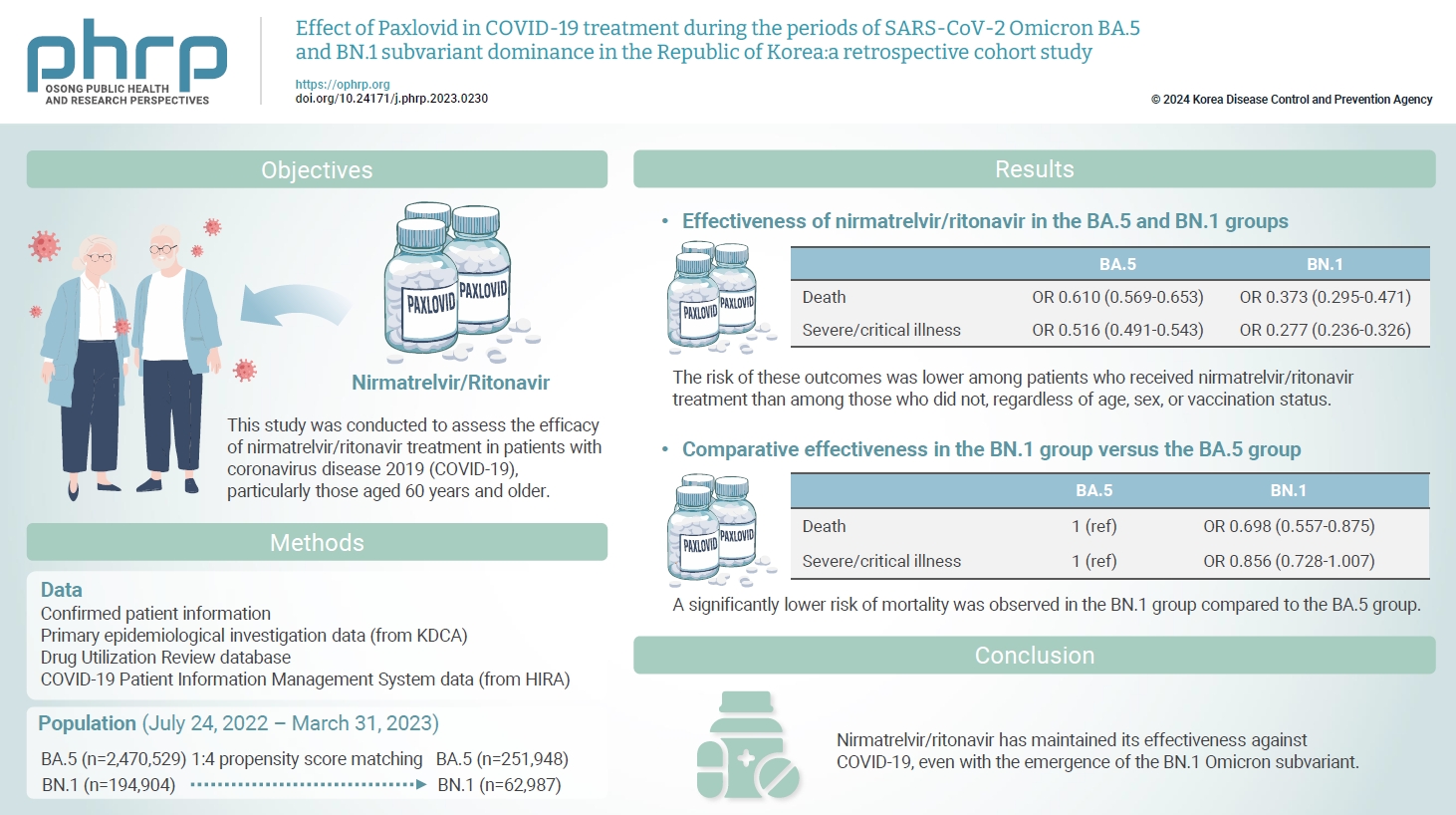- Effect of Paxlovid in COVID-19 treatment during the periods of SARS-CoV-2 Omicron BA.5 and BN.1 subvariant dominance in the Republic of Korea: a retrospective cohort study
-
Dong-Hwi Kim, Min-Gyu Yoo, Na-Young Kim, So Young Choi, Minjeong Jang, Misuk An, Se-Jin Jeong, Jungyeon Kim
-
Osong Public Health Res Perspect. 2024;15(2):137-149. Published online March 28, 2024
-
DOI: https://doi.org/10.24171/j.phrp.2023.0230
-
-
 Graphical Abstract Graphical Abstract
 Abstract Abstract
 PDF PDF
 - Objectives
This study was conducted to assess the efficacy of nirmatrelvir/ritonavir treatment in patients with coronavirus disease 2019 (COVID-19), particularly those aged 60 years and older. Using real-world data, the period during which the BN.1 Omicron variant was dominant was compared to the period dominated by the BA.5 variant.
Methods
In this retrospective cohort study, data were collected regarding 2,665,281 patients infected with severe acute respiratory syndrome coronavirus 2 between July 24, 2022, and March 31, 2023. Propensity score matching was utilized to match patients who received nirmatrelvir/ritonavir in a 1:4 ratio between BN.1 and BA.5 variant groups. Multivariable logistic regression analysis was employed to assess the effects of nirmatrelvir/ritonavir within these groups.
Results
Compared to the prior period, the efficacy of nirmatrelvir/ritonavir did not significantly differ during the interval of Omicron BN.1 variant dominance in the Republic of Korea. Among patients treated with nirmatrelvir/ritonavir, a significantly lower risk of mortality was observed in the BN.1 group (odds ratio [OR], 0.698; 95% confidence interval [CI], 0.557–0.875) compared to the BA.5 group. However, this treatment did not significantly reduce the risk of severe or critical illness, including death, for those in the BN.1 group (OR, 0.856; 95% CI, 0.728–1.007).
Conclusion
Nirmatrelvir/ritonavir has maintained its effectiveness against COVID-19, even with the emergence of the BN.1 Omicron subvariant. Consequently, we strongly recommend the administration of nirmatrelvir/ritonavir to patients exhibiting COVID-19-related symptoms, irrespective of the dominant Omicron variant or their vaccination status, to mitigate disease severity and decrease the risk of mortality.
- COVID-19 outbreak and risk factors for infection in a taekwondo gym in the Republic of Korea
-
Seung Hwan Shin, Eonjoo Park, Sookhyun Kim, Minji Jang, Subin Park, Dong-Hwi Kim, Tae Jong Son, Ji-Hyuk Park
-
Osong Public Health Res Perspect. 2022;13(2):162-170. Published online March 31, 2022
-
DOI: https://doi.org/10.24171/j.phrp.2021.0295
-
-
4,355
View
-
116
Download
-
6
Web of Science
-
5
Crossref
-
 Abstract Abstract
 PDF PDF
- Objectives
Relatively few studies have assessed risk factors for coronavirus disease 2019 (COVID-19) in public facilities used by children and adolescents. This study presents an analysis of a COVID-19 outbreak that occurred in a taekwondo gym in Korea, predominantly among children and adolescents, with the aim of providing insights on managing COVID-19 outbreaks in similar facilities. Methods: All 108 taekwondo gym students and staff received COVID-19 tests. A survey and closed-circuit television analyses were used to identify risk factors. A univariate analysis was conducted, followed by multivariate logistic regression analysis with backward elimination for variables with a significance level <0.10 in the univariate analysis. Results: COVID-19 was confirmed in 30 of 108 subjects at the taekwondo gym (attack rate, 27.8%). The outbreak started in an adult class student. This student transmitted the virus to the staff, who consequently transmitted the virus to adolescent students. In the univariate analysis, the relative risk for younger age (≤9 years) was 2.14 (95% confidence interval [CI], 1.01–4.54; p=0.054), and that for food consumption inside the gym was 2.12 (95% CI, 1.04–4.30; p=0.048). In the multivariate logistic regression analysis, the odds ratio for younger age was 2.96 (95% CI, 1.07–8.20; p=0.036), and that for food consumption inside the gym was 3.00 (95% CI, 1.10–8.17; p=0.032). Conclusion: Food consumption inside the facility and young age were significant risk factors for COVID-19 transmission in this taekwondo gym. Food consumption should be prohibited in sports facilities, and infection prevention education for young students is also required.
-
Citations
Citations to this article as recorded by  - The First Outbreak of Novel Coronavirus Disease 2019 (COVID-19) at an Outdoor Camping Site in South Korea, 2020
Na-Young Kim, Seonhee Ahn, GwangJin Kim, Donghyok Kwon, Young-Joon Park, Sang-Eun Lee
Journal of Epidemiology.2024; 34(4): 203. CrossRef - Risk evaluation of venue types and human behaviors of COVID-19 outbreaks in public indoor environments: A systematic review and meta-analysis
Weiwei Huang, Caroline X. Gao, Danting Luo, Yong Wang, Xiaohong Zheng, Cong Liu, Ying Wang, Yuguo Li, Hua Qian
Environmental Pollution.2024; 341: 122970. CrossRef - SARS-CoV-2 transmission modes: Why and how contamination occurs around shared meals and drinks?
Aure Saulnier, Jean-Michel Wendling, Benoit Hermant, Didier Lepelletier
Food Microbiology.2023; 114: 104297. CrossRef - Risk factors for COVID-19 outbreaks in livestock slaughtering and processing facilities in Republic of Korea
Seongju Choi, Tae Jong Son, Yeon-Kyung Lee
Osong Public Health and Research Perspectives.2023; 14(3): 207. CrossRef - Protective facemask-induced facial thermal stress and breathing burden during exercise in gyms
Qilong Zhong, Jiyun Song, Dachuan Shi, Chung-Hin Dung
Building and Environment.2023; 244: 110840. CrossRef
|